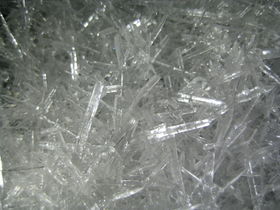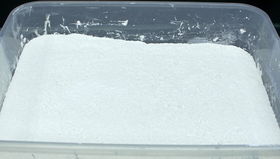Calcium acetate
 Crystals of calcium acetate (monohydrate)
| |
| Names | |
|---|---|
| IUPAC name
Calcium acetate
| |
| Other names
Acetate of lime
Calcium(II) acetate Calcium diacetate Calcium ethanoate Lime acetate Lime pyrolignite | |
| Properties | |
| CaC4H6O4 Ca(CH3COO)2 Ca(OAc)2 | |
| Molar mass | 158.17 g/mol |
| Appearance | Colorless to white hygroscopic crystals |
| Odor | Slight acetic acid odor |
| Density | 1.509 g/cm3 |
| Melting point | 160 °C (320 °F; 433 K) (decomposes) |
| Boiling point | Decomposes |
| 37.4 g/100 mL (0 °C) 34.7 g/100 mL (20 °C) 29.7 g/100 mL (100 °C) | |
| Solubility | Slightly soluble in methanol, hydrazine Insoluble in acetone, ethanol, benzene, toluene |
| Acidity (pKa) | 6.3-9.6 |
| Hazards | |
| Safety data sheet | Macron Fine Chemicals |
| Lethal dose or concentration (LD, LC): | |
| LD50 (Median dose)
|
4280 mg/kg (oral, rat) |
| Related compounds | |
| Related compounds
|
Sodium acetate |
| Except where otherwise noted, data are given for materials in their standard state (at 25 °C [77 °F], 100 kPa). | |
| Infobox references | |
Calcium acetate is a water soluble acetate of calcium. It has a usefully interesting solubility curve, and can be very easily be made into a supersaturated solution.
Contents
Properties
Chemical
Calcium acetate can be easily cracked on heating to make acetone and calcium carbonate.
- Ca(CH3COO)2 → (CH3)2CO + CaCO3
It is also a rather reactive, soluble calcium salt. Treatment of anhydrous calcium acetate with concentrated sulfuric acid produces insoluble calcium sulfate and glacial acetic acid, a useful reagent. Calcium acetate will also gel many alcohols if mixed in correct proportions. Too much calcium acetate will revert the gel back to a liquid.
Physical
Calcium acetate in pure form is a white powder that readily absorbs water to form a translucent, crystalline monohydrate. It can be redried to the anhydrous form with heating, but calcium acetate is one of few ionic salts that can burn on its own, so open flames and very high temperatures will ruin the product.Availability
Not only is this chemical commonly sold as a 'hot ice' substitute, it can be made from calcium carbonate or calcium hydroxide and acetic acid. Avoid using calcium oxide (quicklime) as the neutralization reaction is too exothermic and the mixture may boil.
- 2 CH3COOH + CaCO3 → Ca(CH3COO)2 + H2O + CO2
- 2 CH3COOH + Ca(OH)2 → Ca(CH3COO)2 + 2 H2O
Preparation
Calcium acetate can be easily produced by reaction of calcium hydroxide or carbonate with acetic acid.
Projects
- Make glacial acetic acid
- Make acetic anhydride
- Dry-distill acetone
- Make flaming jelly
- California Snowballs
Handling
Safety
Calcium acetate can be considered mostly harmless. It is, though, a soluble calcium salt, and large oral doses could be harmful.
Storage
Calcium acetate should be stored in sealed bottles, to keep in anhydrous. The hydrated form can be stored in any bottle or container.
Disposal
As it has low toxicity, it can be safely poured down the drain or dumped in the trash.
